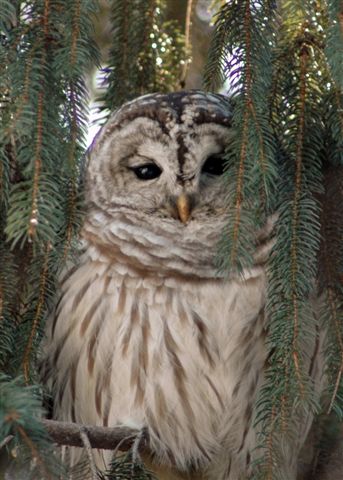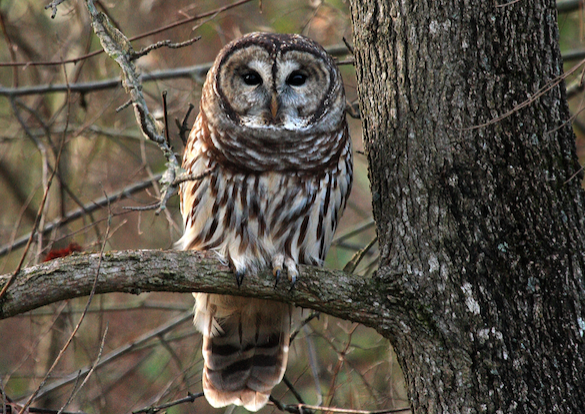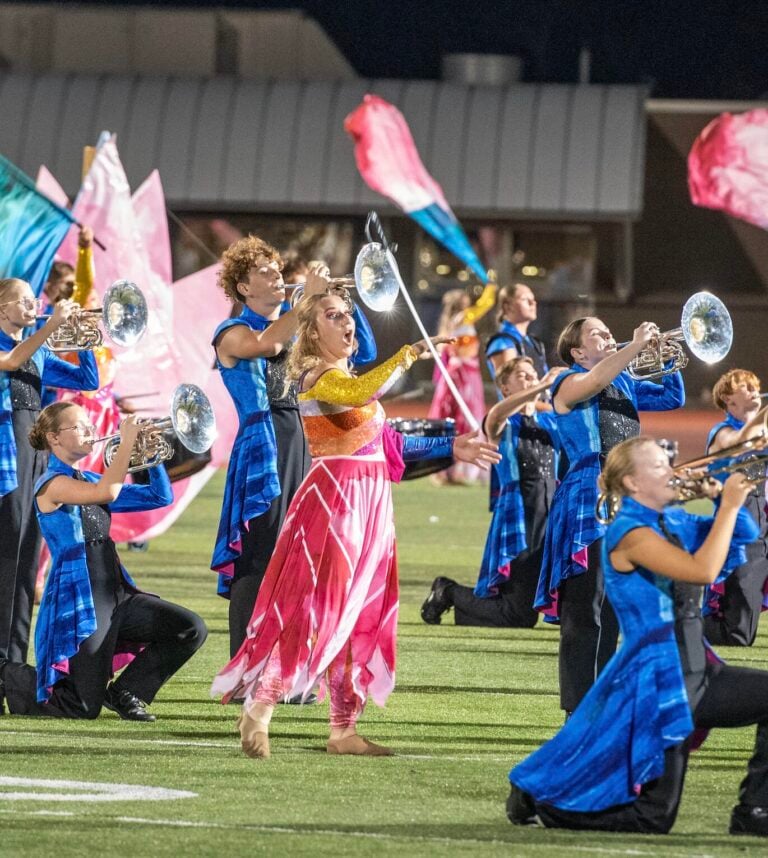Many a person has been awakened in the middle of the night by the maniacal calls of the Barred Owl and wondered aloud, “What was that?” And the Barred Owl’s crazy call was not lost on famed artist and naturalist John James Audubon either, who aptly described, “the discordant screams…in so strange and ludicrous a manner, that I should not be surprised were you to compare these sounds to the affected bursts of laughter which you may have heard from some of the fashionable members of our own species.”

Barred Owls are one of our most vocal owls. They can be heard calling day or night just about any time of the year, especially during February and March as mating season arrives. Their loud and resounding “hoo, hoo, too-Hoo; hoo, hoo, too-Hoo, ooo” is most frequently translated as “Who cooks for you? Who cooks for you, all?” Mated pairs will duet, and if you listen closely you can distinguish the male’s deeper and mellower voice from the female’s slightly higher pitch.
Barred Owls, named for the barring on their chest and belly, are large owls with a round head. While all other owls in the Eastern U.S. have yellow eyes, Barred Owls have dark brown eyes. They eat a variety of prey, from insects to geese. Meadow voles, shrews and deer mice are some of their favorite dinner fare. They will perch and wait for prey, or fly through the trees and swoop down on their prey. Barred Owls prefer dense, moist wooded areas. They can also be found in older neighborhoods with plenty of mature trees.
With a three to four-foot wingspan, they are one of our larger owls. As with other birds of prey, females are larger than males. They appear to be about the same size as Great Horned Owls, however Barred Owls weigh significantly less, do not have ear tufts, and are not nearly as powerful. In fact, Barred Owls often fall victim to Great Horned Owls.
Cavity nesters, incubation of two to four eggs lasts about a month. Young Barred Owls leave the nest a month later. They cannot fly, but will crawl out of the nest to sit on branches, hence the name “branchers.” They fledge at about six weeks old, though their parents care for them for at least four months, much longer than most other owls.
Barred owls are common throughout eastern North America. Over the years they have expanded their range, especially northwest into Canada, Washington, Oregon, and California where they overlap with endangered Northern Spotted Owls. Scientists believe this invasion is one of the causes for the recent decline of Spotted Owls. Barred Owls are larger, more aggressive and displace Spotted Owls. They also interbreed with Spotted Owls. These hybrids are often called “Sparred Owls.”
Because of their nocturnal nature, most owls are difficult to see. Barred Owls though, are one of the easier owls to see and hear. So, the next time you’re walking through the woods, listen for the Barred Owl’s signature call. There’s often one close by asking, “Who cooks for you?”
Gayle Pille is a local naturalist and nature writer who many know through her work to establish the five-mile network of nature trails at Highland Cemetery in Ft. Mitchell. She created the cemetery’s popular 25-year-old Wildlife Enhancement Program and works with a small team of volunteers to maintain the cemetery’s wooded walking paths. An avid birdwatcher, Gayle also builds custom wildlife nest boxes for businesses, parks and residences through her business, www.woodlandhabitat.com
























Gayle always look forward to reading what you write about. You should have been a science teacher.